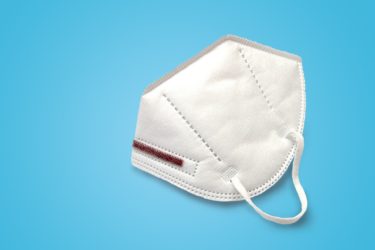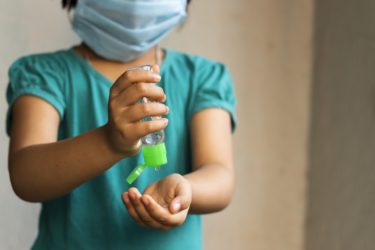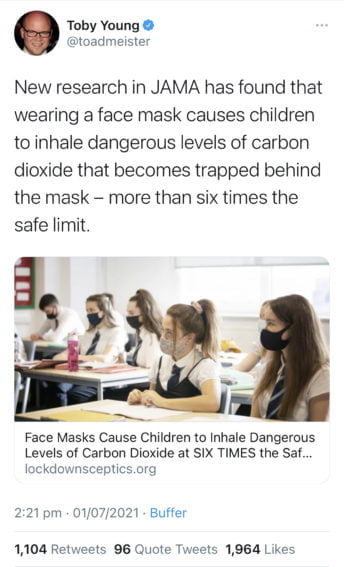Earlier this month, certain contrarian pundits wasted no time in amplifying a new study which purported to demonstrate that the use of face masks contributed to high levels of carbon dioxide in inhaled air among children. The study was published on the 30th of June in the Journal of the American Medical Association (JAMA), and LockdownSceptics, a website founded by Toby Young, waited all of 24 hours before publishing a piece by Will Jones, with the headline ‘Face Masks Cause Children to Inhale Dangerous Levels of Carbon Dioxide at SIX TIMES the Safe Limit’.
Despite the capital letters, and the editorial’s notorious record of misquoting research, I thought it would be worthwhile taking a closer look at the study. It certainly sounds worrying and, if the findings are credible, it would fly in the face of the truly vast preponderance of evidence that masks are a safe and useful public health tool during a pandemic.
The Trial
The study’s cohort consisted of 45 healthy children. The trial measured ‘carbon dioxide content in inhaled air with and without 2 types of nose and mouth coverings in a well-controlled, counterbalanced, short-term experimental study’. The trial’s measurement team used a G100 CO2 incubator analyser to measure carbon dioxide levels inside the face mask via a measurement tube fixed to the face of the child.
The paper’s method notes state that:
A 3-minute continuous measurement was taken for baseline carbon dioxide levels without a face mask. A 9-minute measurement for each type of mask was allowed: 3 minutes for measuring the carbon dioxide content in joint inhaled and exhaled air, 3 minutes for measuring the carbon dioxide content during inhalation, and 3 minutes for measuring the carbon dioxide content during exhalation.
The study found that the carbon dioxide content inside the face masks reached levels ‘higher than what is currently deemed acceptable by the German Federal Environmental Office by a factor of 6’. The research letter states that ‘this was a value reached after 3 minutes of measurement’, and that ‘the value of the child with the lowest carbon dioxide level was 3-fold greater than the limit of 0.2% by volume’. In it’s discussion notes, the letter reports that ‘most of the complaints reported by children can be understood as consequences of elevated carbon dioxide levels in inhaled air’.
The Main Problem
Perhaps it is best to begin with the study’s biggest, most glaring flaw: the research team measured CO2 levels in the air inside a face mask, they found that it was high, and then they assumed that the total amount of air the child was breathing contained this level of CO2 exposure. However, air inside a face mask (the ‘dead space’) constitutes only a fraction of the total amount of air (the ‘tidal volume’) that moves in or out of the lungs with each respiratory cycle. The total amount of air a masked person inhales is made up partly from air inside the mask, but also from air outside the mask (where CO2 levels are often far lower). The air a swimmer breathes, for example, comes partly from the air already inside the snorkel, but mostly from the air outside the snorkel.

The only way that air inside a mask could constitute 100% of the tidal volume we inhale, and therefore be reflective of actual exposure, is if the mask formed an impermeable seal around a person’s mouth and nose. This would be far from ideal, as not being able to inhale air from outside the mask would cause us to die pretty quickly.
Associate Professor of Exposure Assessment Science at Harvard, Joseph G. Allen compares this to ‘measuring benzene concentrations in a bowl right around the gas tank of your car during refuelling, and then saying that’s the concentration you are breathing’. Perhaps this basic error might have been spotted if one of the study’s authors were an expert in the field of exposure assessment science. None were.
Any study examining inhaled air for dangerous levels of anything (with or without a mask) would need to measure the tidal volume of inhaled air to determine the true level of exposure. This study did not. Therefore, it is impossible to know what the actual level of exposure of CO2 is in any of the masked children in this study. This oversight undermines our ability to glean anything meaningful from the results of this trial.
In order to determine actual exposure, and then compare that to levels deemed acceptable by public health authorities, a trial would need to account for the fraction of air outside of the mask too. In fact, studies have demonstrated that gas exchange is not significantly affected by the use of a mask, that face masks are unlikely to cause overexposure to carbon dioxide or impair lung function during physical activity, and that the benefits clearly outweigh the risk when it comes to face mask use as a safety measure against infection from SARS-CoV-2.
Now, some readers who might be feeling sympathetic to concerns brought about by this study might be thinking ‘ah – but if you’re saying that air outside a mask constitutes a significant chunk of the air that is being inhaled by a masked person, you’re admitting that air from the outside world, which could contain covid, can enter the lungs despite wearing a mask. You’re admitting that masks don’t work!’
The reason why this point does not hold water is because masks filter air, rather than preventing it from entering our lungs altogether. If they prevented all outside air from entering our noses and mouths we would not be able to breathe. Masks are not perfect and, yes, this does mean that the occasional aerosol or water droplet could conceivably sneak past the barrier of our mask, especially if others around us are infected and not masked, but overall risk of infection has still been lowered significantly. Widespread mask use is recommended by public health authorities precisely because masks are less about filtering Covid out of the air we inhale, and more about catching the infected droplets in the air we exhale. The more people wear masks, the lower the overall risk level is for all of us. Primarily, wearing a mask protects others around you by stopping air droplets from reaching other people.
The fact that masks are not a perfect safeguard against becoming infected is uncontroversial in the global medical consensus, which is why it is recommended that mask mandates are implemented in conjunction with other safety measures such as social distancing and ventilation.
The Other Problems
At the beginning of the trial’s research letter, it is stated that:
A large-scale survey in Germany of adverse effects in parents and children using data of 25 930 children has shown that 68% of the participating children had problems when wearing nose and mouth coverings.
The authors appear to rely quite heavily on this supplementary research here, and it’s ominous implications. It certainly sounds very damning. That is, until you read the survey and notice this bright red warning right at the top of the page:

As is clear from this editorial note, the survey suffered from a long list of limitations, including sample bias, reporting bias, and lack of a control group. The journal itself makes clear the study cannot demonstrate a causal relationship between masks and adverse effects in children. Quite how the authors of the JAMA study, let alone it’s peer-reviewers, could have failed to mention this survey’s numerous limitations before referencing it uncritically, seems inexplicable.
The JAMA mask study’s measurement team also used inappropriate equipment for the experiment. They used a G100 CO2 incubator analyser which, as its name suggests, is used primarily for assessing the CO2 levels in an incubator, rather than in the air in front of a child’s face. As Eve Bloomgarden (MD) writes on JAMA’s comment section,
There is no data supporting the use of G100 as a valid and accurate instrument for the type of measurement used in this study.
Conditions in the space between a human face and a face mask are much less consistent than conditions in an incubator (CO2 can vary dramatically during a breathing cycle, for example). Therefore results are likely to be less reliable, and measurements less reflective. This is not accounted for or mentioned in the study.

There also appear to be missing data in the study’s published results. The trial protocol states that the team intended to measure ‘blood oxygenation, heart rate and breathing frequency to figure out which physiological consequences the wearing of NMC will have’. Yet none of these measurements were included in the published results. Blood gas measurements such as pO2 or pCO2 (the content, or partial pressure, of oxygen and carbon dioxide in the blood) were absent from the reported findings. Measuring basic health metrics like these would be essential in ascertaining the clinical significance of the trial’s results.
The more we read into the study’s methods, the more bizarre and preposterous they seem. The study’s lead author, Harald Walach (PhD), notes that in order to make sure that inhalations and exhalations were measured separately, a doctor ‘carefully observed the breaths’. No further information is given beyond this. To be clear – a fundamental aspect of this study, the results of which are being used to argue that we should abandon nationwide mask mandates in schools altogether, rests entirely on ‘a doctor watched carefully’. Typically, capnography (the monitoring of the concentration of carbon dioxide) involves the use of sophisticated medical apparatus, rather than simply a person watching another person breathing. It isn’t entirely clear who exactly was doing the watching, or if they recorded the distinct categories well or reliably.
Given all of it’s deep methodological flaws, it’s surprising to see this paper being taken seriously – and that surprise is only deepened when we look at the publication record of the lead author, Harald Walach.
Lead Author’s Background
Harald Walach is Professor for Research Methodology in Complementary Medicine at Viadrina European University Frankfurt. He has a long record of researching and writing favourably about alternative medicines. In 2012 he was widely criticised for work on a master’s thesis which appeared to support the existence of telepathy. He has written for blogs extolling the virtues of homeopathy. More recently, he authored a peer-reviewed research paper that falsely claimed two people died from COVID-19 vaccinations for every three cases the vaccines prevented. The article was published by the journal Vaccines on the 2nd of July, and then retracted one day later.
Walach is also a ‘member’ of the very same charity that funded the JAMA study; an initiative called ‘Doctors and Scientists for Health, Freedom and Democracy’. In it’s own words, the organisation ‘came together during the corona crisis in our criticism of the excessive restrictions’. The group has been a vocal proponent of anti-mask, anti-vax and anti-lockdown arguments ever since the beginning of the pandemic. However, in the research letter of the JAMA study, no conflict of interest was disclosed.
JAMA may well have retracted this study by the time you read this article and, in such an event, I suspect we’ll hear no mea culpa from any of the pundits who rushed to raise the alarm based on it’s spurious findings*. Because by the time we unravel the misinformation from one alarmist news story, they will have already moved on to two more. As a result of their premature coverage, much of the damage will have already been done. When one side doesn’t value taking the time to check the research properly, it’s impossible to keep up.
The fact that none of the glaring red flags that surround this study prevented certain pundits from using it to decry mask mandates in schools, despite their unambiguous efficacy, leads us to two possible conclusions; either these pundits did not read the paper they are using to bolster their arguments, or they did and are ignoring deliberately it’s questionable quality of research. We should consign their rallying cries to the warehouse of fear mongering and false alarms. The uncompromising pursuit of truth is not part of their remit.
* Update: As of July 16th 2021, Toby Young appears to have quietly deleted his tweet promoting Jones’ coverage of the misleading study, but not before it garnered over 1000 retweets. A screenshot of the tweet is reproduced below. As predicted, neither Young nor Jones have acknowledged that the study was fatally flawed, and the article on LockdownSceptics still stands, uncorrected.




